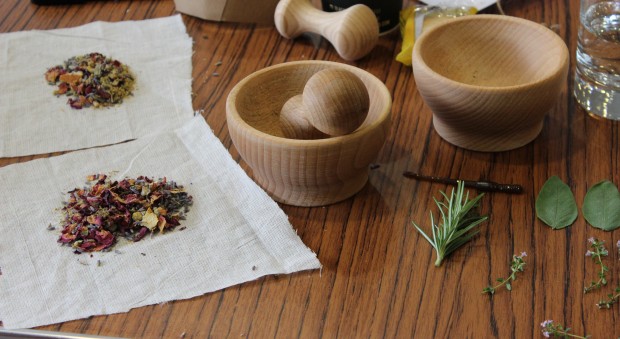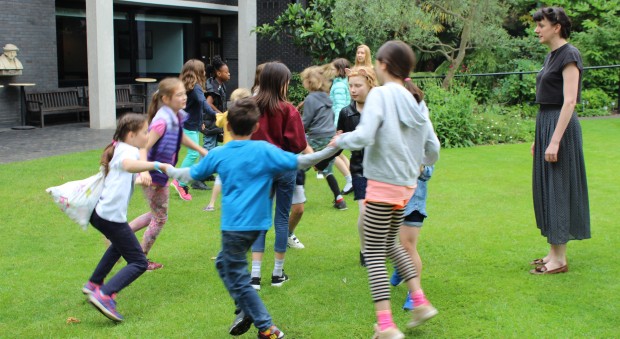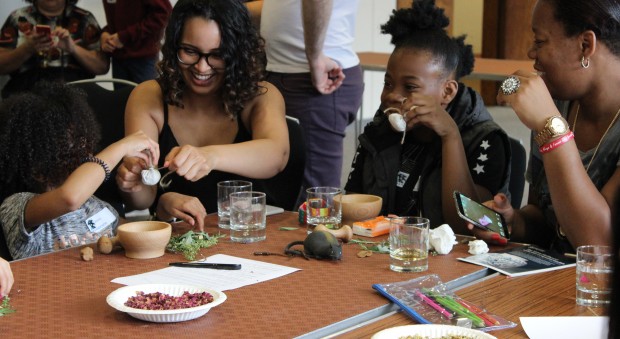Do you have memories of concocting the messiest, foul smelling mud pies in the garden as a child? Grubby knees and grass stains may have been an everyday occurrence for previous generations, but time spent playing in parks, woods and fields has dramatically shrunk for children today due to lack of green spaces and the increase of technology.
The Royal College of Physicians' (RCP's) library, archive and museum team ran its third edition of its popular Plague and potions children’s workshop this May half term; a rare chance for our youngest visitors to explore the RCP Garden of Medicinal Plants whilst learning about the Great plague that struck London in 1665.
For the first time, we teamed up with Handmade Apothecary, a duo of medically trained herbalists, both passionate about sharing the lost, traditional knowledge of herbs with others and the community through running workshops, walks and talks on herbal remedy making, natural beauty and botany. Their aim is to help others to re-establish a bond with nature and use plants and natural ingredients for health, home and self-care.

‘Leech me! Leech me!’: learning about the plague
In a room filled with the scent of freshly-cut sprigs of mint, sage and rosemary from the RCP medicinal garden, 30 children and adults took part in the workshop. It was clear from the start of the session that this gruesome subject continues to fascinate children with its gory details of bubonic boils, rats, leeches and carts in the streets of London collecting dead plague victims.
Eyes widened and gasps went up as it was described that Londoners were often locked in their homes with their families, even if they weren’t infected with the plague. As the story of blood-letting during the Plague was told, leeches (rubber) were prescribed from a glass jar to the group, met with excited cries of ‘Leech me! Leech me!’ as it was explained that blood-letting was a treatment used at the time, believed to purge the body of poisoned or excess blood.
The children joined in the storytelling by becoming plague doctors themselves; donning the distinctive bird-like masks, long capes, hats and gloves.

Exploring the RCP medicinal garden
After a quick rendition of Ring-a-ring o’ roses – the nursery rhyme whose lyrics it is often suggested describes the symptoms of the Plague – on the RCP lawn, the children were able to explore the medicinal garden, with RCP head gardener, Jane Knowles:
It was a pleasure to have the children in the garden and to see how much fun they had touching and smelling and picking their plants for their potions. I am glad that we can provide this living educational resource. They seemed to love being out in the sunshine amongst the roses and the adults seemed to really appreciate the environment as well.
Identifying common herbs and learning about their uses, Harry Potter fans were also thrilled upon the discovery of a real mandrake (Mandragora officinarum) in one flower bed.
Kim from Handmade Apothecary commented:
It was really inspiring to see the children interacting with plants and discovering that they aren't just 'background green'. That in fact, these plants have all sorts of uses and exciting stories that can connect them not only to nature, but to the history of our ancestors, history and culture.

Becoming a plague doctor
Back in the workshop, children enthusiastically pummelled herbs and dried flowers with pestles and mortars, filling muslin bags to make their own pomanders: a sweet-smelling ball of herbs that was often worn around the neck or wrist, believed to ward away disease.
In a second activity, plague doctor masks were created rolling card to create the distinctive bird-like ‘beak’ which would have held dried flowers, herbs, spices to keep away bad smells. Physicians believed the herbs would counter the ‘evil’ smells of the plague and prevent them from becoming infected.

Natalie Craven, public programmes officer
